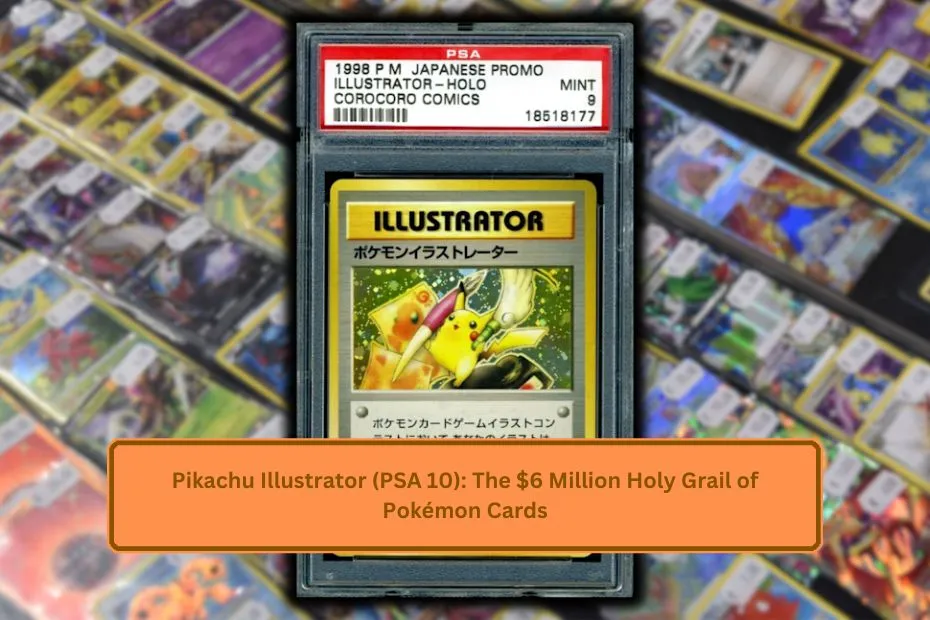The Pokémon Trading Card Game (TCG) has evolved from a children’s hobby into a billion-dollar collectible empire. While some cards fetch millions, a growing segment of collectors is targeting the mid-tier grails—cards valued between $10,000 and $30,000. These cards offer a balance between rarity, historical significance, and investment value, making them prime targets for both seasoned and new collectors. Below, we delve deep into 10 such cards, examining their origins, market trends, and what makes them so coveted.
1. 1999 1st Edition Holographic Charizard (PSA 9)
- Estimated Value (2025): $12,000 – $18,000
- Why It’s Valuable: The 1st Edition Holo Charizard is iconic. While PSA 10s fetch over $100K, a PSA 9 still commands over $12K. It’s part of the original Base Set and remains a cultural symbol of 90s nostalgia.
- Investment Insight: The PSA 9 offers a more accessible price point with long-term potential. High demand and global recognition keep it relevant in auctions.
2. 2000 Pokémon Neo Genesis 1st Edition Lugia (PSA 9)
- Estimated Value (2025): $10,000 – $15,000
- Why It’s Valuable: Lugia’s popularity and the notorious print quality issues of Neo Genesis make high grades rare. The card’s striking artwork and playability boosted its prominence.
- Investment Insight: PSA 10s are scarce and go for over $70K, but a PSA 9 remains a solid collector’s piece with rising demand.
3. 1999 Tropical Wind (Tropical Mega Battle Promo)
- Estimated Value (2025): $15,000 – $20,000
- Why It’s Valuable: Only given to participants of the 1999 Tropical Mega Battle tournament in Hawaii, making it incredibly rare. The card’s origin in early competitive Pokémon lore enhances its historical significance.
- Investment Insight: These promos rarely appear on the open market, and their scarcity ensures strong long-term value.
4. 1999 Pokémon Japanese Promo No. 1 Trainer (TMB)
- Estimated Value (2025): $25,000 – $30,000
- Why It’s Valuable: Awarded to winners of Japan’s early Pokémon tournaments, each card was personalized, further limiting supply. These cards were never publicly sold.
- Investment Insight: The rarity, unique status, and competitive background make this card one of the holy grails under $30K.
5. 2006 Pokémon EX Dragon Frontiers Gold Star Charizard (PSA 9)
- Estimated Value (2025): $14,000 – $22,000
- Why It’s Valuable: Gold Star cards are already rare, but Charizard tops them all. Its shiny black appearance and limited release window increase its value.
- Investment Insight: PSA 10s sell for $50K+, making PSA 9s attractive for mid-tier investors seeking growth potential.
6. 1998 Japanese Promo Pikachu Illustrator (Poor Condition)
- Estimated Value (2025): $25,000 – $30,000
- Why It’s Valuable: While mint copies can exceed $500K, even heavily damaged versions are worth tens of thousands. Only 39 were originally distributed.
- Investment Insight: Any condition of this card is gold. It’s among the rarest and most historic Pokémon cards ever made.
7. 2005 Pokémon EX Deoxys Gold Star Rayquaza (PSA 9)
- Estimated Value (2025): $12,000 – $18,000
- Why It’s Valuable: Rayquaza is immensely popular, and the Gold Star version is one of the hardest pulls in the EX era. PSA 10s have topped $50K.
- Investment Insight: This card represents peak EX-era collecting, with strong nostalgia and future growth potential.
8. 1999 Base Set 1st Edition Shadowless Blastoise (PSA 10)
- Estimated Value (2025): $20,000 – $25,000
- Why It’s Valuable: While overshadowed by Charizard, Blastoise was a fan-favorite starter. Its 1st Edition, Shadowless status and pristine grade make it extremely valuable.
- Investment Insight: A great addition for those completing the “Big Three” Base Set starters in high grade.
9. 2002 Pokémon Trophy Card – Battle Road Spring No. 2 (Japanese)
- Estimated Value (2025): $15,000 – $25,000
- Why It’s Valuable: These were awarded to winners in Japan’s Battle Road tournaments. Limited to just a handful of players per event.
- Investment Insight: Scarcity and competitive origin make these cards a stealthy but elite investment in the mid-tier market.
10. 1996 Japanese Base Set Charizard (No Rarity Symbol, PSA 9)
- Estimated Value (2025): $12,000 – $16,000
- Why It’s Valuable: The no-rarity version is considered a first print of the Japanese base set. It lacks the rarity symbol found on most cards and is extremely scarce.
- Investment Insight: Japanese collectors prize this version highly. Prices are climbing as Western buyers discover its significance.
Comparison
| Card Name | Year | Grading | Estimated Value | Unique Features |
|---|---|---|---|---|
| 1st Ed. Charizard | 1999 | PSA 9 | $12K-$18K | Most iconic Base Set card |
| Neo Genesis Lugia | 2000 | PSA 9 | $10K-$15K | Rare 1st Ed. print |
| Tropical Wind | 1999 | Raw/NM | $15K-$20K | Promo tournament card |
| No. 1 Trainer (TMB) | 1999 | Raw/Low Pop | $25K-$30K | Personalized trophy card |
| Gold Star Charizard | 2006 | PSA 9 | $14K-$22K | Shiny black variant |
| Illustrator Pikachu | 1998 | Poor | $25K-$30K | Most legendary promo |
| Gold Star Rayquaza | 2005 | PSA 9 | $12K-$18K | Rare shiny pull |
| 1st Ed. Blastoise | 1999 | PSA 10 | $20K-$25K | Classic Base Set |
| Trophy Battle Road #2 | 2002 | Raw/Low Pop | $15K-$25K | Japan-exclusive |
| No Rarity Charizard | 1996 | PSA 9 | $12K-$16K | First Japanese print |
Conclusion
The Pokémon TCG is no longer just about nostalgia—it’s a thriving investment market. While million-dollar Pikachu Illustrator cards grab headlines, the $10K-$30K tier offers rich opportunities for collectors and investors alike. Each of these ten cards carries a story, a slice of history, and a place in the evolving legacy of Pokémon. As the market matures and scarcity intensifies, owning one of these mid-tier treasures may become not just a passion project—but a legacy asset.


